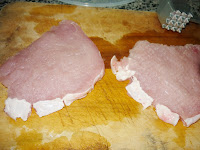This is another favourite with the children which is
easy to prepare. It is my variation of the famous Hong Kong pork chop rice. I
use tomato rice instead of fried rice therefore no frying is involved especially
when using the air fryer. You can choose any type of cheese as there are no
hard and fast rules to follow.
Ingredients
Cooked
rice (amount depends on how many people eating)
2 - 3 pieces of boneless pork chops with a little fat on it
2
tbsp tomato ketchup mixed with 1 cup of water
Grated cheddar and parmesan cheese
Minced garlic
Grated cheddar and parmesan cheese
Minced garlic
Snip
the fat at the edge if you are using loin chops to prevent the chops from curling up
Pound
the meat with a meat hammer to tenderise the pork
Marinade
½ tsp sugar
1 tbsp Shaoxing wine
Salt and pepper
½ tsp sesame oil
Combine the chops with the marinade and leave for 1 to 2 hours
Set the temperature to 190 degrees
Set the cooking time to 17 minutes and let it warm up for 1 minute.
Put in the chops and start cooking
Turn the chops over when the 15 minutes are up
Resume cooking for another 10 minutes or until the chops are done
Resume cooking for another 10 minutes or until the chops are done
Place the sliced pork chops on top of the rice
Cover with the grated cheese
Put back into the air fryer for 5 minutes or until the cheese is nicely browned
Put back into the air fryer for 5 minutes or until the cheese is nicely browned
Non-air fryer method
Pan-fry or grill the marinated pork in the oven
Put the cooked rice in a large bowl and add some fried garlic.
Pour in the diluted tomato ketchup and mix thoroughly
Transfer the rice to an oven-proof dish
Slice the pork chops and place them on top of the rice
Slice the pork chops and place them on top of the rice







































































